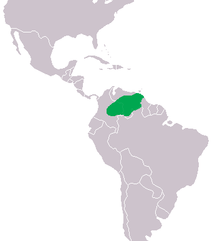Orinoco crocodile
| Orinoco crocodile | |
|---|---|
 |
|
| Scientific classification | |
| Kingdom: | Animalia |
| Phylum: | Chordata |
| Class: | Sauropsida |
| Order: | Crocodilia |
| Family: | Crocodylidae |
| Subfamily: | Crocodylinae |
| Genus: | Crocodylus |
| Species: | C. intermedius |
| Binomial name | |
|
Crocodylus intermedius Graves, 1819 |
|
 |
|
| Range (green) | |
The Orinoco crocodile (Crocodylus intermedius) is a critically endangered crocodile. Its population is very small and it can only be found in freshwater environments in Colombia and Venezuela, in particular the Orinoco River and its tributaries. Extensively hunted for their skins in the 19th and 20th centuries, this species is one of the most critically endangered species of crocodiles. It is a very large species, in fact the largest species of crocodilian and predator in the Americas. Males have been reported up to 6.6 m (22 ft) in the past, but such sizes do not exist today, 5.2 m (17 ft) being a more widely accepted maximum size. Males average at 4.1 m (13 ft) in length weighing 380 kg (840 lb), while females are slightly smaller averaging 225 kg (496 lb). Sexual dimorphism is not as profound as in some other species. The coloration is light even in adults.
The biology of the Orinoco crocodile is poorly documented in the wild, mostly due its small population. It is thought to have a more piscivorous diet with an opportunistic nature resulting in a generalist predatory behavior. The Orinoco crocodile is an apex predator and will take the opportunity to prey on a variety of reptiles, birds, and mammals, including caimans on occasion. The prey base is mostly made up of large predatory fish, challenging the general view by the locals complaining about the crocodile hunting local fish to very low numbers. Despite its large size, the Orinoco crocodile rarely poses a threat to humans, despite several reports. Reproduction takes place in the dry season when the water level is lower. Orinoco crocodiles are hole nesters, digging holes in the sand to lay their eggs. The females guard the nests and young up to several years.
...
Wikipedia

